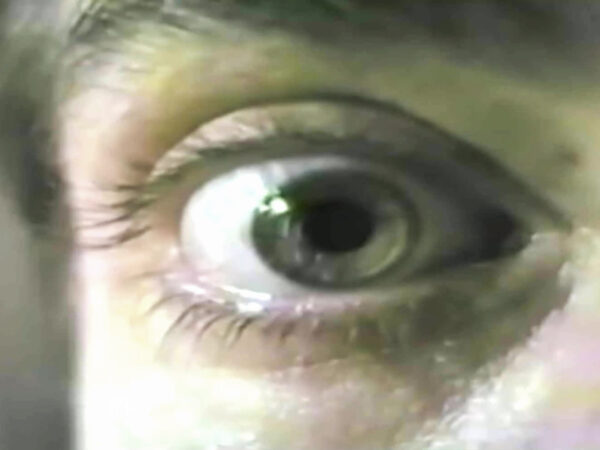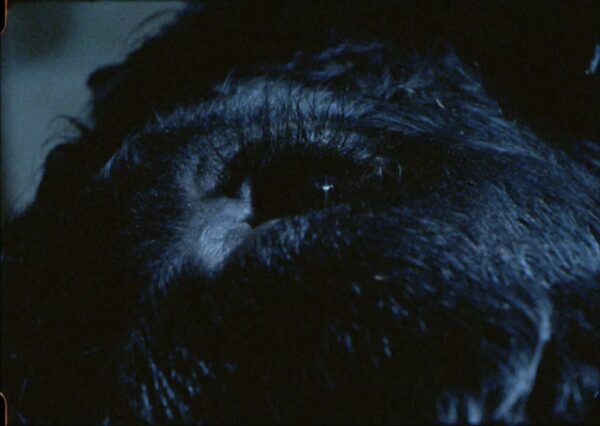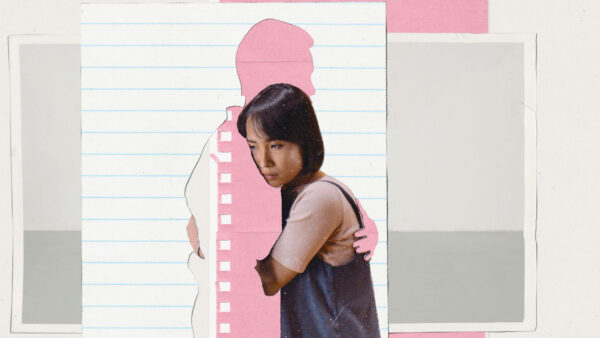King of the Video Club
Dancing in the Light
Julie Petríková’s film Dancing in the Light, which screened at XPOSED Queer Film Festival in Berlin earlier this year, focuses on 1980s videographer and New York queer icon Nelson Sullivan, recuperating his memory and love for his community, but also delving into his particular way of video-making during an era that was still not in the habit of turning the camera the other way round, onto the self.

The name of videographer Nelson Sullivan might ring fewer bells than that of Andy Warhol, yet they both boast an important status as queer icons of the New York art scene, influential for a certain milieu often centred around the artist safe haven of the Chelsea Hotel. Friend and witness to the early fame of figures such as Michael Musto, RuPaul or Christina Superstar and other “Club Kids”, Sullivan, too, used the camera in the service of counterculture, capturing on his exhaustive, vlog-like tapes the lives—public and private—of the crème de la crème of New York’s downtown.
As a few biographical notes describe them, Sullivan’s cassettes act much like a 20th century video rendition of Giorgio Vasari’s Lives of the Artists, an extensive who’s who of the queer and misfit masters of a neo-Renaissance anchored in 1980s club and underground culture. Given their up-close accounts of queer parades, gay clubs and drag shows, but also the backstage lives of performers, Sullivan’s tapes have provided inspiration for kindred spirits, as well as a sense of queer historicity—one Drag Race winner quotes them as being detrimental to her formation.
Yet despite this legacy, Nelson Sullivan remains somewhat lesser known. Julie Petríková’s film Dancing in the Light, which screened at XPOSED Queer Film Festival in Berlin earlier this year, recuperates Sullivan’s memory and love for his community, but also delves into his particular way of video-making during an era that was still not in the habit of turning the camera the other way round, onto the self.
By the time Nelson Sullivan picked up his camera to chronicle the artists and drag queens of the 1980s New York underground, the city’s avant-garde had already become accustomed to using film—and then video—as tools for ethnographic practice, from the aforementioned Warhol, to Jonas Mekas’ intimate assemblages or to George Kuchar’s string of diaries. Ever since its beginnings, video has played an important part in capturing counterculture and the “alternative kind” in the US, all the way from underground video clubs back to the Guerrilla Television movements of the 1960s and 1970s, where groups and collectives used it as a tool for social change and for documenting resistance, protests and political turmoil.
Because of its portability and accessibility, the technology became a kind of refuge for the outcasts and those against the status quo, but also for the self—most famously expressed in art critic Rosalind Krauss’ 1970s definition of video as an essentially “narcissistic medium” (i.e. ontologically concerned with the self, rather than self-involved). Often thought of as an opposite to cinema, an unprestigious, poor and amateur-like medium, video has always been on the outskirts, and so, has lended itself to the outskirts, to underprivileged and underrepresented communities.
Even within this avant-garde tradition, even within a context where the video diaries of Kuchar and the likes were self-narrated or had much to do with personal history, Sullivan’s auto-reflexive use of the camera stands out as somewhat unusual. The artist himself is very much aware of it, often commenting on how people may look at him and his camera as if he “was crazy”. Sullivan’s gesture of turning the camera upon himself and talking to it as if there was an audience on the other side—his constant frustrations of “Why doesn’t everyone turn the camera around” suggest it is all but a no-brainer—seems to have been answered only about 30 or 40 years later, with the vlog-style video practices of today. Unlike the more widespread practice where the author comes through as an off-screen voice or as a glimpse caught in the mirror, Sullivan’s constant presence within the shot, often filming on the move as he interacts with his surroundings, friends, or beloved dog, are not so much a reflective, subjective diary point-of-view as they are a kind of video-verité cinema reporting on direct experience.
From Pride parades to club performances, domestic settings, chats with his friend—and favourite subject—Christina Superstar at the Chelsea Hotel, then mourning her death, Dancing in the Light picks up on Sullivan’s understanding of the video camera as a kind of perpetual companion, more of an aide-vivre than an aide-memoire. As Petríková extracts them from his archive, Sullivan’s videos do not operate under the psychological (psyche-related) or memory-centric questions of the video artists of his time, but anchor themselves in bits of mundane life—ordering hamburgers, complaining about friends not inviting him to parties, shots from the passenger seat, one last tape filmed as casually as possible, just as Sullivan returns home from the beach.

© Dancing in the Light (Julie Petríková, 2025)
By selecting these specific moments after rummaging through the videographer’s tapes, Petríková is careful to highlight one key insight into Sullivan’s practice. Having one night passed the video recorder to his friend, he gazes back into the camera, with the image distorted around its edges and the zoom bringing everything towards an abstract blur: his videos are not reality, says Sullivan, but, instead, pieces from which reality can be reconstructed. As he muses over their deforming fish-eyed effect and heavy pixelation, Sullivan concludes his tapes are “undiluted information”, but crucially not reality itself—implying he is not a documentarian, but something else entirely. Despite centering on Sullivan’s friendship with Christina, Petríková’s film is not as interested in the downtown life captured by the artist, but in these moments of self-awareness and medium awareness when Sullivan reflects on his practice and on what was still an idiosyncratic manner of interacting with the camera, often finding it somewhat silly that other people don’t do it more.
It is inevitable, however, for a film like Dancing in the Light not to collapse under the weight of its larger archive, in this case 1800+ hours of tape material, readily available on the internet via the YouTube channel 5ninthavenueproject. As much as it refocuses discourse on the tools of representation and on Sullivan’s relationship with the camera, thus emphasising his credibility as a videomaker, Petríková’s 20-minute selection of moments runs the risk of feeling like a teaser for the complete archive. Condensation, albeit necessary for the format, seems rather unfortunate for an individual as cheeky and loquacious as Sullivan—one particularly keen to let reality flow in front of the camera and hardly flustered by dead time and unspectacular moments. Dancing in the Light achieves its mission as an introduction to and reappraisal of Sullivan, but going through his extensive tapes provides the more unabridged experience, one truer to that sentiment of undiluted information he often appreciated about the video camera.
This recentering on medium awareness—save for a few divagations with Christina, some moments featuring Warhol and RuPaul, and fragments of one Pride parade—also leaves out the artist’s important standing as in-house historiographer of the underground. Petríková catches Sullivan referring to himself as “the most convenient thing there is”, and while it’s true that much of his practice centred on his own body and persona as a mediator of realities (as would that of a vlogger), his status as a direct witness and celebrator of downtown New York doesn’t transpire as much as one would hope. Anchoring the film in Sullivan’s relationship with Christina Superstar and their familiar meetings at the Chelsea Hotel offers cohesion to Petríková’s film, but it ends up describing a transgressive community only partially and superficially, with other figures from the same scene appearing only in short, fleeting montages.
There is the argument that to include images of better known figures of 1980s New York might have divested attention from Sullivan—to a contemporary Drag Race-era audience, it would be hard for a film looking into Ru Paul’s rise to fame not to make that its primary selling point. Yet, by avoiding these early fame days of some notable queer icons, Dancing in the Light rather neglects the value of Nelson Sullivan’s tapes as a one of a kind, direct, and rarely seen account of an era, and as important pieces of queer and LGBTQI+ history.
In part, it is true that this fleetingness of the club experiences and of eye-catching performances is also Dancing in the Light’s strongest appeal. By avoiding what is evidently extraordinary, Petríková shows its behind the scenes, a mundanity of the underground, a humane ordinariness that goes against what society and the status-quo has deemed outcasts to be. But it’s worth comparing a film like Petríková’s to one like Lesley Loksi Chan’s very recent Lloyd Wong, Unfinished (2025), which also treads the same themes of video, queerness and self-representation. By reworking a found archive of a Canadian gay and AIDS activist, Chan crucially considers Wong a co-author of her film, and positions her work in relation to a furthering of the archive and to a kind of queer, communitary responsibility. Wong doesn’t take the archive for granted or as a pool of creative stock—as a lot of contemporary found footage filmmaking tends to do—but, through revealing her research and her notes, she carefully questions what archival practice should do when confronted with a legacy.
Picking up on Sullivan’s own problematisation of his practice, Dancing in the Light offers some valuable insight into the videographer’s relationship with the camera and the camera’s relationship with the self, but it misses out on a communitary, legacy-like aspect that is inherently tied to Sullivan’s historical standing within the New York underground.




There are no comments yet, be the first!